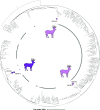Multiple Introductions of SARS-CoV-2 Alpha and Delta Variants into White-Tailed Deer in Pennsylvania
- PMID: 36000731
- PMCID: PMC9600874
- DOI: 10.1128/mbio.02101-22
Multiple Introductions of SARS-CoV-2 Alpha and Delta Variants into White-Tailed Deer in Pennsylvania
Abstract
The SARS-CoV-2 pandemic began by viral spillover from animals to humans; today multiple animal species are known to be susceptible to infection. White-tailed deer, Odocoileus virginianus, are infected in North America at substantial levels, and genomic data suggests that a variant in deer may have spilled back to humans. Here, we characterize SARS-CoV-2 in deer from Pennsylvania (PA) sampled during fall and winter 2021. Of 123 nasal swab samples analyzed by RT-qPCR, 20 (16.3%) were positive for SARS-CoV-2. Seven whole genome sequences were obtained, together with six more partial spike gene sequences. These annotated as alpha and delta variants, the first reported observations of these lineages in deer, documenting multiple new jumps from humans to deer. The alpha lineage persisted in deer after its displacement by delta in humans, and deer-derived alpha variants diverged significantly from those in humans, consistent with a distinctive evolutionary trajectory in deer. IMPORTANCE Coronaviruses have been documented to replicate in numerous species of vertebrates, and multiple spillovers of coronaviruses from animals into humans have founded human epidemics. The COVID-19 epidemic likely derived from a spillover of SARS-CoV-2 from bats into humans, possibly via an intermediate host. There are now several examples of SARS-CoV-2 jumping from humans into other mammals, including mink and deer, creating the potential for new animal reservoirs from which spillback into humans could occur. For this reason, data on formation of new animal reservoirs is of great importance for understanding possible sources of future infection. Here, we identify extensive infection in white-tailed deer in Pennsylvania, including what appear to be multiple independent transmissions. Data further suggests possible transmission among deer. These data thus help identify a potential new animal reservoir and provide background information relevant to its management.
Keywords: Odocoileus virginianus; SARS-CoV-2; animal reservoir; coronavirus; white-tail deer; zoonosis.
Conflict of interest statement
The authors declare no conflict of interest.
Figures





References
-
- Temmam S, Vongphayloth K, Salazar EB, Munier S, Bonomi M, Régnault B, Douangboubpha B, Karami Y, Chretien D, Sanamxay D, Xayaphet V, Paphaphanh P, Lacoste V, Somlor S, Lakeomany K, Phommavanh N, Pérot P, Donati F, Bigot T, Nilges M, Rey F, Werf Svd, Brey P, Eloit M. 2021. Coronaviruses with a SARS-CoV-2-like receptor-binding domain allowing ACE2-mediated entry into human cells isolated from bats of Indochinese peninsula. Res Square doi: 10.21203/rs.3.rs-871965/v1. - DOI
-
- Zhou H, Ji J, Chen X, Bi Y, Li J, Wang Q, Hu T, Song H, Zhao R, Chen Y, Cui M, Zhang Y, Hughes AC, Holmes EC, Shi W. 2021. Identification of novel bat coronaviruses sheds light on the evolutionary origins of SARS-CoV-2 and related viruses. Cell 184:4380–4391. doi: 10.1016/j.cell.2021.06.008. - DOI - PMC - PubMed
-
- Xiao K, Zhai J, Feng Y, Zhou N, Zhang X, Zou J-J, Li N, Guo Y, Li X, Shen X, Zhang Z, Shu F, Huang W, Li Y, Zhang Z, Chen R-A, Wu Y-J, Peng S-M, Huang M, Xie W-J, Cai Q-H, Hou F-H, Chen W, Xiao L, Shen Y. 2020. Isolation of SARS-CoV-2-related coronavirus from Malayan pangolins. Nature 583:286–289. doi: 10.1038/s41586-020-2313-x. - DOI - PubMed
-
- Holmes EC, Goldstein SA, Rasmussen AL, Robertson DL, Crits-Christoph A, Wertheim JO, Anthony SJ, Barclay WS, Boni MF, Doherty PC, Farrar J, Geoghegan JL, Jiang X, Leibowitz JL, Neil SJD, Skern T, Weiss SR, Worobey M, Andersen KG, Garry RF, Rambaut A. 2021. The origins of SARS-CoV-2: a critical review. Cell 184:4848–4856. doi: 10.1016/j.cell.2021.08.017. - DOI - PMC - PubMed
Publication types
MeSH terms
Supplementary concepts
Grants and funding
LinkOut - more resources
Full Text Sources
Medical
Miscellaneous
